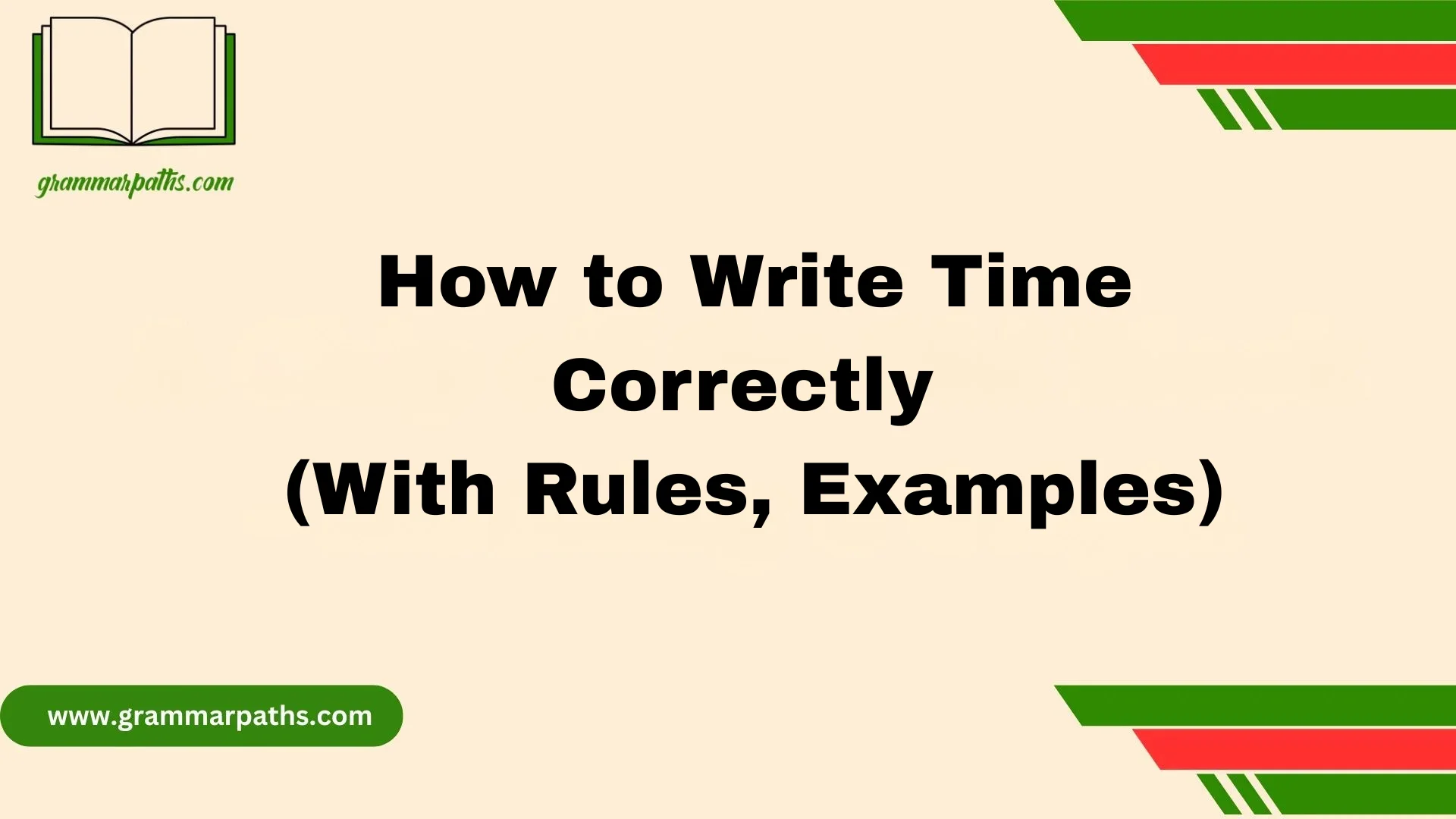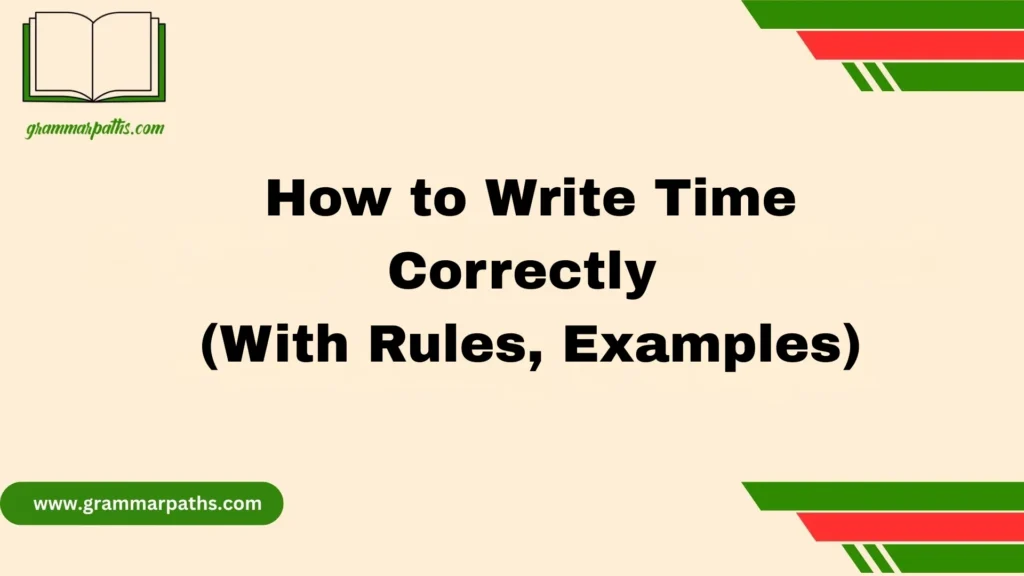Writing time correctly is an essential skill in both formal and informal communication. Whether you are drafting a business letter, sending a professional email, or creating academic content, the way you express time can affect clarity and readability. Many people overlook the small details of time formatting, yet these details often make a big difference in how the message is understood.
There are multiple conventions for writing time, depending on the context. For example, in the 12-hour clock system, you use a.m. and p.m. to indicate morning and evening, while the 24-hour clock is common in military time and international formats. Choosing between words or numerals (like “six o’clock” vs. “6:00”) also depends on the level of formality in writing.
Consistency is key when applying punctuation in time. Some styles prefer “10:30 a.m.” while others allow “10.30am” or even “1030 hrs.” Following the correct style guide—whether it’s APA, MLA, or Chicago style—helps maintain accuracy.
Quick Summary?
Writing time correctly depends on consistency and context. In formal writing, time is usually written in the 12-hour clock with a.m. and p.m. (e.g., 7:30 a.m., 4:45 p.m.) or in the 24-hour format without them (e.g., 19:30). Always use a colon between hours and minutes, and keep a space before a.m./p.m. (not 7:30am, but 7:30 a.m.). For round hours, you may write simply 7 a.m. instead of 7:00 a.m.. In informal writing or speech, people often say 7 o’clock or half past seven. The key rule is to pick a style—12-hour or 24-hour—and use it consistently.
Understanding Time Formats
The 12-Hour Clock (AM/PM)
The 12-hour system is the most common format in the United States. Here’s what you should know:
- AM stands for ante meridiem (Latin for “before midday”).
- PM stands for post meridiem (“after midday”).
- AM covers midnight (12:00 a.m.) through 11:59 a.m.
- PM covers noon (12:00 p.m.) through 11:59 p.m.
Capitalization and punctuation:
- AP Style recommends lowercase with periods: a.m., p.m.
- Chicago Manual of Style allows both lowercase with periods (a.m.) or small caps (AM).
- Avoid inconsistency—don’t write 7 am in one place and 7:00 A.M. in another.
Examples:
- Correct: “The meeting starts at 8 a.m. sharp.”
- Incorrect: “The meeting starts at 8 a.m. in the morning.” (redundant)
The 24-Hour Clock (Military or International Time)
The 24-hour system avoids AM/PM confusion. It’s widely used in aviation, medicine, global business, and by the military.
- Hours run from 00:00 (midnight) to 23:59.
- Noon is written as 12:00.
- 1 p.m. is 13:00, 6 p.m. is 18:00, 11 p.m. is 23:00.
Conversion Example:
| 12-Hour Format | 24-Hour Format |
| 1:00 a.m. | 01:00 |
| 12:00 p.m. | 12:00 |
| 3:30 p.m. | 15:30 |
| 11:59 p.m. | 23:59 |
Common mistake: Writing “13:00 p.m.” (redundant).
Pro tip: In business or academic writing with international readers, the 24-hour format often eliminates ambiguity.
Style and Formatting Rules
Standardization Across Style Guides
Different style guides have different rules for writing time. Here’s a quick comparison:
| Style Guide | Example | Notes |
| AP Style | 7 p.m. | Always use numerals; lowercase a.m./p.m. with periods. |
| Chicago Manual of Style | 7:00 p.m. or 7 p.m. | Prefers numerals; allows omission of “:00” for round hours. |
| MLA | 7:00 p.m. | Consistent with Chicago; more formal academic tone. |
| APA | 7:00 p.m. | Always numerals; lowercase a.m./p.m. with periods. |
Key takeaway: Pick a style guide based on your field and stick with it.
Common Formatting Elements
- Colons vs. periods:
- US English: 7:30 p.m.
- British English: often 7.30 pm
- Spacing: Always add a space before a.m./p.m. (7 p.m. not 7p.m.).
- Leading zeros:
- Correct in 24-hour format: 07:00
- Incorrect in 12-hour format: 07:00 a.m. → write 7:00 a.m.
Common Errors in Writing Time
Even professionals slip up. Here are the most frequent mistakes:
- Redundancy: “10 a.m. in the morning” (remove in the morning).
- Misuse of noon and midnight: Writing 12 a.m. for noon confuses readers. Use 12 noon or simply noon.
- Mixing numerals and words: Don’t write “seven o’clock at 7:00.” Choose one format.
- Inconsistency: Switching between 7 p.m. and 7:00 PM in the same document.
Special Cases and Exceptions
Noon vs Midnight
The 12:00 hour is the trickiest. Many people mix up whether noon is 12 a.m. or 12 p.m.
- Noon = 12:00 p.m.
- Midnight = 12:00 a.m.
But to avoid confusion, many style guides suggest writing:
- 12 noon instead of 12:00 p.m.
- 12 midnight instead of 12:00 a.m.
Example in contracts: Instead of saying “The lease ends at 12 a.m. on June 1,” write “The lease ends at midnight on June 1.”
Time Ranges and Durations
When writing ranges:
- Use an en dash (–) without spaces: 7–9 p.m.
- Or write with “to”: 7 p.m. to 9 p.m.
Avoid redundancy:
- Incorrect: 7 p.m. tonight to 9 p.m. tonight
- Correct: 7–9 p.m. tonight
Inclusive vs exclusive ranges:
- “Office hours are 9 a.m.–5 p.m.” means until 5 sharp.
- “Office hours are 9 a.m. through 5 p.m.” includes the 5 o’clock slot.
Approximate and Informal Expressions
Time can be expressed casually, especially in conversation or creative writing.
- Formal: “The train departs at 4:15 p.m.”
- Informal: “The train leaves around quarter past four.”
Examples of informal expressions:
- “About 5 o’clock”
- “Half past seven”
- “Around noon”
Writers should match the tone of their audience—formal for business, flexible for storytelling.
Writing Time in Different Contexts
Academic and Research Writing
- Always stick to one formatting system throughout.
- APA and MLA require numerals for exact times: “The experiment began at 3:45 p.m.”
- Avoid words like “mid-afternoon” unless describing contextually rather than precisely.
Professional and Business Writing
Emails, reports, and schedules demand precision.
Good practice examples:
- Meeting invite: “Meeting scheduled for 10:30 a.m. EST on March 15.”
- Report: “Data was collected between 2 p.m. and 6 p.m. daily.”
Adding time zones is crucial for remote work and international teams.
Creative and Narrative Writing
Writers often bend the rules for readability or atmosphere.
Example:
- Formal: “He left at 11:47 p.m.”
- Narrative: “He slipped out just before midnight.”
Consistency still matters, but creative writers can prioritize flow and mood over strict formatting.
International and Cross-Cultural Communication
Different regions follow different norms.
| Region | Preferred Format | Example |
| US | 12-hour + a.m./p.m. | 7:45 p.m. |
| UK | 24-hour, or 12-hour without periods | 19.45 or 7.45 pm |
| EU | 24-hour clock | 19:45 |
| Military | Strict 24-hour | 1945 hours |
When writing for a global audience, always clarify time zones. Example: “The webinar begins at 9:00 a.m. EST (2:00 p.m. GMT).”
Practical Examples and Case Studies
Correct vs Incorrect Formats
| Incorrect | Correct |
| 7pm | 7 p.m. |
| 12 a.m. (for noon) | 12 noon |
| 07:00 a.m. | 7:00 a.m. |
| 10 p.m. tonight evening | 10 p.m. tonight |
Case Study: Airline Scheduling Error
In 2018, a European airline mistakenly listed a departure as 12:00 a.m. when it meant 12:00 p.m. Passengers assumed midnight instead of noon, and dozens missed their flight. The issue stemmed from inconsistent formatting in different languages on the airline’s website. Afterward, the airline adopted the 24-hour format for all schedules to avoid costly confusion.
Best Practices and Quick Reference Guide
Here’s a concise checklist you can use:
- Be consistent with your chosen style (AP, Chicago, etc.).
- Use a.m./p.m. correctly—never with redundant words.
- Replace 12 a.m./p.m. with midnight or noon.
- Write ranges as 7–9 p.m. or 7 p.m. to 9 p.m.
- Always include time zones for global communication.
- Proofread documents to catch inconsistencies.
Conclusion
Mastering how to write time correctly is not just about following rules—it’s about ensuring clarity and professionalism in every piece of writing. Whether you are working on business documents, academic papers, or casual everyday communication, the correct time format helps avoid misunderstandings. Remember to stay consistent with your chosen style, whether it’s the 12-hour clock with a.m. and p.m. or the 24-hour clock format. By paying attention to small details like punctuation, spacing, and capitalization, you make your writing more accurate, polished, and easy to read. Developing this habit will greatly improve your communication skills and leave a lasting impression of professionalism.
FAQs
Q1: Should I use a.m. and p.m. in formal writing?
Yes, most style guides allow a.m. and p.m. in formal writing, but always check the specific guide you’re following.
Q2: What is the difference between 12-hour and 24-hour clock formats?
The 12-hour clock uses a.m. and p.m., while the 24-hour clock runs from 00:00 to 23:59, often used in military time and international settings.
Q3: Is it correct to write “12 a.m.” and “12 p.m.”?
To avoid confusion, it’s better to write midnight (12:00 a.m.) and noon (12:00 p.m.) instead of just using numbers.
Q4: Can I write time in words instead of numbers?
Yes, in more formal or literary writing, you can use words like “six o’clock,” but in technical or business contexts, numerals are preferred.
Q5: Do I need to use periods in a.m. and p.m.?
It depends on the style guide. For example, APA uses lowercase with periods (a.m., p.m.), while some British styles use uppercase without periods (AM, PM).

Grace Marie is the dedicated writer behind GrammarPaths.com, where she shares her passion for English grammar, idioms, and writing mastery. With a strong background in language studies and years of experience helping learners improve their communication skills, Grace creates clear, practical, and engaging content that makes English easy to understand.










